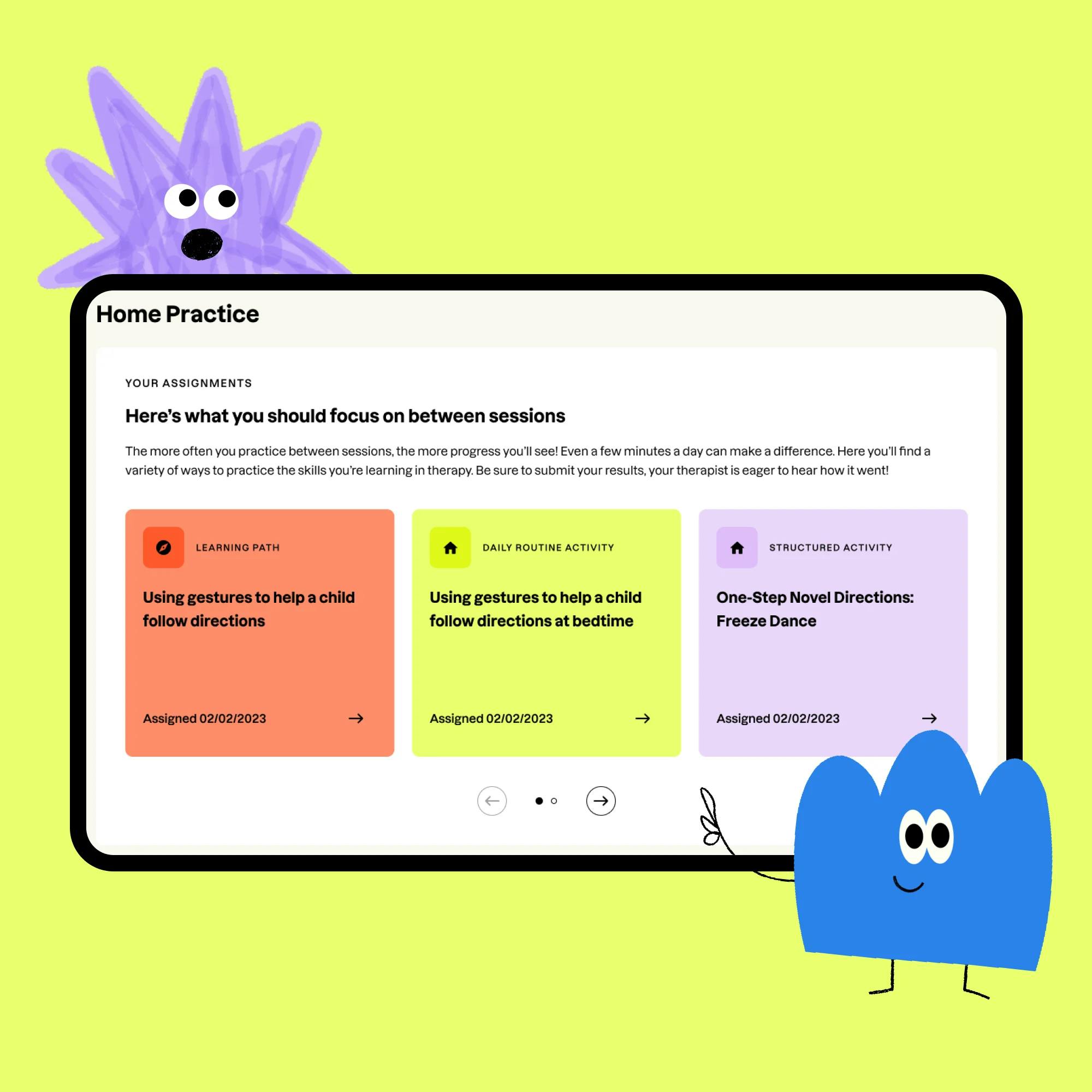
Playful Speech Therapy Helps 3-Year-Old Make Quick Progress with a Stutter
 Abby Barnes, M.S., CCC-SLP
Abby Barnes, M.S., CCC-SLP
A mom’s intuition is a powerful thing. Pricilla was concerned that her 3-year-old son, Pierce, might have a stutter. Speaking in general seemed challenging for him, especially when it came to making everyday connections with his parents, or even asking for food and or a drink. She knew that he needed support with his communication.
A friend recommended that she contact Expressable, and Pierce was matched with a speech therapist, Tiffany Simpson, M.S., CCC-SLP. That’s when everything started changing for the better. Just six months in speech therapy made all the difference for Pierce and his speech skills.
Support for children who stutter
Speech therapy helps kids who stutter boost their confidence and speak more freely. Find the right therapist for your child at Expressable.
 Get started
Get startedFinding the right speech therapy strategies for stuttering
As with all speech therapy, Pierce’s time with Tiffany began with a speech evaluation. This helped Tiffany identify the types of goals and therapy strategies that would help Pierce speak more fluently, or smoothly.
At first, Tiffany focused on indirect therapy strategies that involved parent training and modeling. Indirect therapy strategies work to adjust factors that can contribute to a person’s stuttering. For example, Tiffany and Pricilla discussed not telling Pierce, “Don’t talk too fast.” Instead, they found other ways to talk with him to encourage smoother speech.
Tiffany also used direct therapy strategies, which focus directly on the way a person speaks. Each person who stutters needs their own unique mix of fluency strategies. Tiffany was able to determine that these strategies were just right for Pierce:
“Robot speech”: Also called syllable-timed speech, it involves saying a sentence with equal stress on each syllable, similar to speaking with a metronome.
“Stretchy speech”: Involves stretching, or prolonging, syllables in words to help prevent stuttering from happening.
“Turtle speech”: Also called slow speech, this involves adding small pauses between words or elongating vowels and sounds in words.
Initially, stuttering therapy focuses on teaching fluency strategies and modeling, or demonstrating, how to do them. But Tiffany says, “About halfway through therapy, Pierce started to automatically follow a delayed model of strategies. This means he didn’t only repeat the strategy right after I modeled it for him–he could still do it later. He began using these strategies more independently during play-based tasks, and he needed fewer cues, or prompts, from me over time.”


Lots of playtime equals more participation
As Pierce got better at using these stuttering strategies on his own, Tiffany continued making sure that therapy sessions were play-based and child-led. Speech therapy works best for young children when they can practice new techniques while playing. After all, play is what kids do best!
Pierce enjoyed playing interactive games where he could use lots of energy. He especially loved iPad games with robots or animals. Tiffany always had his favorite games ready for each session. She recalls that in one of his games, the character sings a silly song. Pierce loved this and it always made him smile. These fun, engaging sessions made all the difference for his participation and learning!
The power of practicing stuttering strategies at home
The key to successful speech therapy is making sure parents and caregivers understand the techniques used, so they can practice with their child at home. We want kids to use their new speech skills independently and in places like home and school, not just during speech therapy.
Pricilla was motivated and eager to learn stuttering strategies to help Pierce between sessions. Because of her dedication, Pierce carried over his new skills and made excellent–and fast!–progress in speech therapy.
Curious or concerned?
Our free screener is tailored by age and covers all areas of speech, language, and feeding. Find out if your child might need speech therapy.
 Screener for children
Screener for childrenA core part of our mission at Expressable is making caregiver involvement as easy as possible. All families have access to our client portal, where their speech therapist assigns personalized education and practice activities:
Learning Paths that explain and reinforce therapy strategies (for example, Pierce’s Learning Paths focused on syllable-timed speech, stretched syllables, and reduced rate speech)
Demo videos that show real techniques in action
Home practice activities you can do during everyday routines, like talking with family members in the car or ordering food at a restaurant
Text messaging support, so you can ask questions, get reminders, or receive tips from your therapist between sessions


Success with online speech therapy for a toddler
Many studies have shown the effectiveness of online speech therapy for toddlers and preschoolers. But it’s still common for parents to question how well it will work. At the beginning, Pricilla wondered if Pierce would be able to do online speech therapy due to his young age. She quickly realized that online therapy would work well for him. “Tiffany was able to keep him engaged, but also redirect him easily when needed,” she recalls. Flexibility is key for young kids in speech therapy, no matter if it’s in person or online. Pricilla was pleased with the way Tiffany interacted with Pierce and made the most of their time together.
When asked what she would say to other families considering online speech therapy, Pricilla says, “Honestly, give it a try. As wild as it sounds to have speech therapy online, we are now in an age of technology where anything is possible. This really showed me a different perspective on speech therapy.”
Pricilla also appreciated the convenience of teletherapy. She says, “Whether you're a working parent or a stay-at-home parent, online speech therapy is convenient–and it works!”


Smoother speech after 6 months of therapy
After about 6 months of sessions, Pierce was ready to graduate. “I’m so proud of the progress Pierce made,” Tiffany says. “He became confident in expressing himself, and he was such a joy to have in speech therapy sessions!”
Pricilla agrees that Pierce is more confident. She notes that he’s grown in his vocabulary and is able to express himself much more fluently. She’s especially noticed this when he interacts with other kids his age. As she puts it, “Expressable is a life changer!”
If you think your child might need support, reach out to Expressable today! We’ll match you with a licensed speech therapist who can evaluate your child and determine if speech therapy is recommended. Find the right speech therapist for your little one by clicking here!
How Expressable Can Help
Concerned your child isn't reaching age-expected milestones? Looking for communication support from a professional? Expressable is a national online speech therapy practice serving children and adults. We treat all major areas of communication and feeding, offer flexible hours including evenings and weekends, and accept most major health insurance plans. We’re proud to have earned more than 3,000 5-star reviews from our clients (4.9/5 average).
Our therapy model is centered on parent and caregiver involvement. Research proves that empowering caregivers to participate in their loved one’s therapy leads to better outcomes. That’s why we combine live, 1-on-1 speech therapy with personalized education and home practice activities for faster progress.
Communication is more than words. It’s how we share how we feel and show who we are. We’re here to help you or your child do just that.











